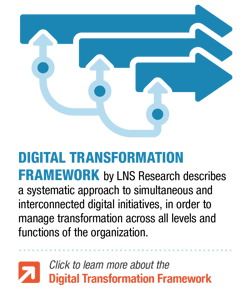The #MondayMusings Industrial Transformation blog series provides insight and analysis for executives from the previous week’s briefings, events, and publications @LNSResearch.
Click here to speak to Matt Littlefield
 Analyst firms are notoriously bad at addressing major technology trends once they pass peak hype. Many of them simply move on to the next big tech trend with little or no accountability to all the companies that just decided to start working on whatever was on the radar for the past two years. “Sorry, and good luck with that, it was so 2016…”
Analyst firms are notoriously bad at addressing major technology trends once they pass peak hype. Many of them simply move on to the next big tech trend with little or no accountability to all the companies that just decided to start working on whatever was on the radar for the past two years. “Sorry, and good luck with that, it was so 2016…”
Others are slow to react. I just read an analyst blog post by Bill Ruh, CEO of GE Digital, saying that digital might “take longer in industrial." Although I agree in part with the sentiment, Digital Transformation in the industrial sector is going to take more than just time. In particular, that perspective underestimates the realities of what it takes to transform a company or industry, especially when it comes to culture and organizational design.
Finally, large firms publish research on the topic and track technologies along the hype cycle. As the Internet of Things (IoT) and digital move past peak hype, so will most analysts. The good ones won't abandon the technology and will increase attention again once adoption starts in earnest among mid- to late adopters.
At LNS Research, we are not technology analysts. We are researchers and advisors that continually focus on Industrial Transformation. Subsequently, we see the Industrial Internet of Things (IIoT) and digital just as another enabler – one that has bigger hype than most. As the market continues to mature, our perspective and research will shift from stressing future vision and answering the question, "What can we do," to a focus on time to business value, culture, change management, and “What should we do?”
First Mover Advantage
 GE clearly became "the first mover in digital in the industrial sector," when it created GE Digital and launched Predix 6 years ago. Competitors were forced into a reactionary posture and have been playing catch up ever since. Given this dynamic, it was not surprising how many in the industry looked on smugly as Reuters published an article about GE which will likely go down in infamy as the beginning of the end for industrial digital hype. The article was less than positive and pointed out many of the internal challenges GE faced during its own Digital Transformation.
GE clearly became "the first mover in digital in the industrial sector," when it created GE Digital and launched Predix 6 years ago. Competitors were forced into a reactionary posture and have been playing catch up ever since. Given this dynamic, it was not surprising how many in the industry looked on smugly as Reuters published an article about GE which will likely go down in infamy as the beginning of the end for industrial digital hype. The article was less than positive and pointed out many of the internal challenges GE faced during its own Digital Transformation.
Guess what? Transformation is a messy business and we all better get used to it. I was not surprised by anything in the article; perhaps only that Reuters dared to publish it. But it is easier to say the emperor has no clothes once the emperor has retired.
GE’s Posture Today
This past Friday the LNS analyst team had the opportunity to meet with Bill Ruh and hear about his vision for the future of GE Digital. From the conversation, it was clear that GE has a strong culture, largely focused on Lean and Six Sigma processes, a foundation that will serve the company well moving forward. In recent years the company extended this management system to include Lean start-up principles, internally known as Fast Works at GE.
In many of GE’s business units, Fast Works has been used to drive meaningful change in business processes and increased value for customers. In the early years of the GE Digital launch, the company was slow to identify customer problems it could solve, applied finite resources to develop a minimum viable product, and once it identified a market-accepted solution, iterate and innovate. Conversely, the company applied almost unbounded resources to develop and market the Predix platform, which has been a step removed from solving specific customer problems.
This is old news and nothing that GE and its customers didn’t already know before we hit peak hype or the Reuters article was published. Prior to the article, GE Digital had already (and rightly so) moved to focus its solutions more tightly on applications than the underlying platform, with substantial market success now from applications like APM for example.
What was news from the Reuters article was that, under Flannery’s new leadership, this trend towards truly applying Lean start-up principles to digital will likely increase and perhaps dramatically so. Predix is not going to be a platform for every industrial application. Instead, Predix will live in a multi-platform environment, with a focus on delivering applications and the ecosystem needed to solve asset-centric vertical industry challenges than initially thought, like those found in upstream oil and gas, power generation, transportation, and more.
What does the future look like for GE?
GE was the first mover when it came to digital in the industrial sector, although many believe that means GE will also be the first loser as we move past peak hype. I don't think that will be the case.
The company will likely stay ahead of competitors if it doesn’t try to revert to a pre-peak hype posture, can effectively manage the coming transition, stays committed to the space, and embraces the principles of Lean start-up to deliver meaningful solutions in focused areas with agility.
It seems to me that Flannery understands this, and with his new leadership role, is free to shed the baggage of old and embrace a past peak-hype digital future.
Either way, it is going to make for a very interesting installment of GE’s Minds and Machines event in San Francisco come October 25.